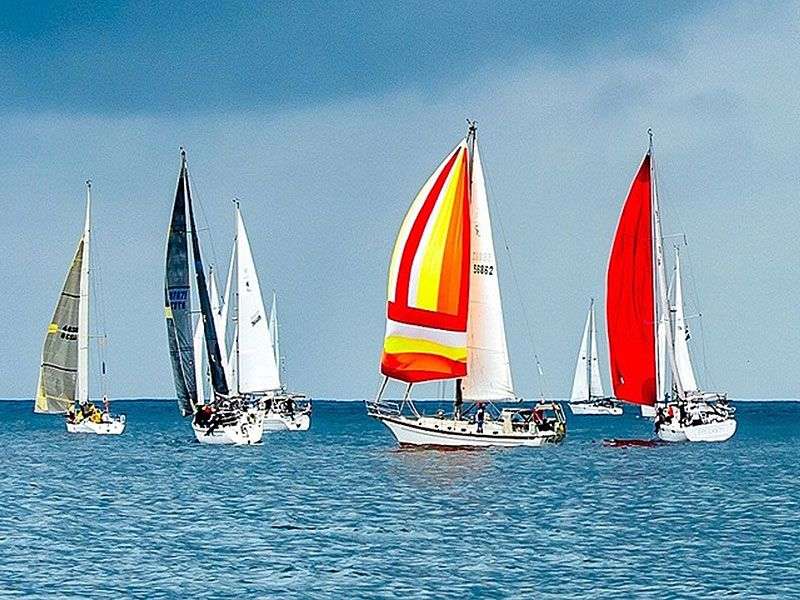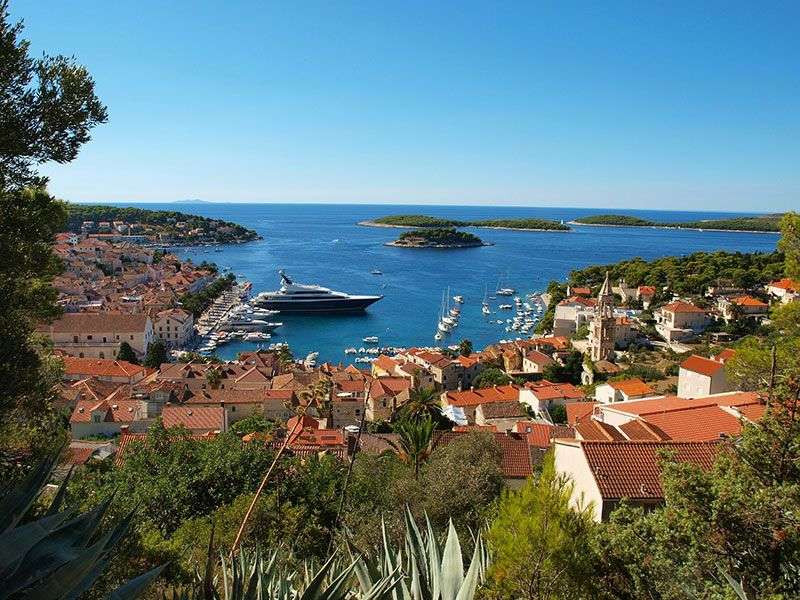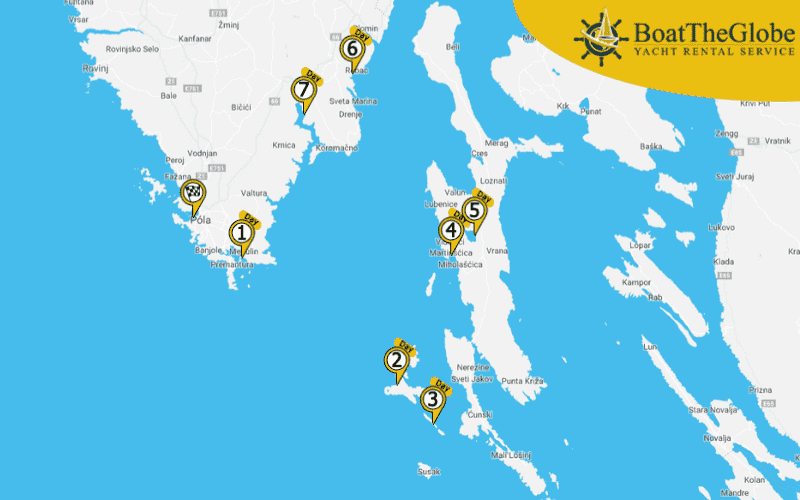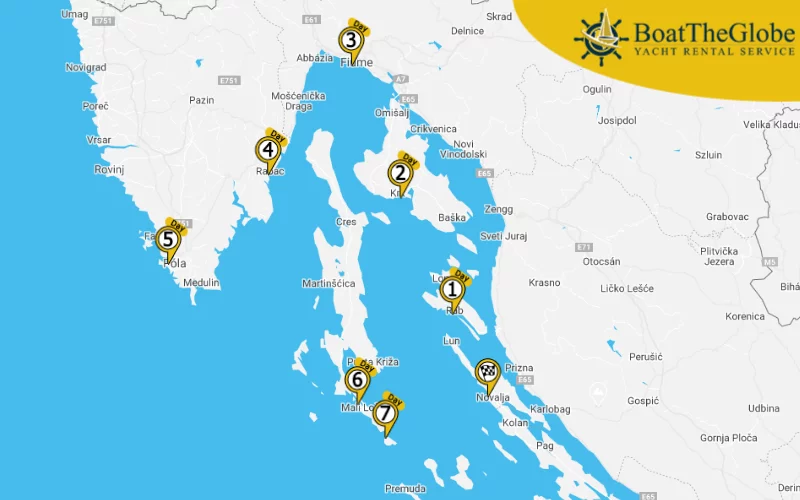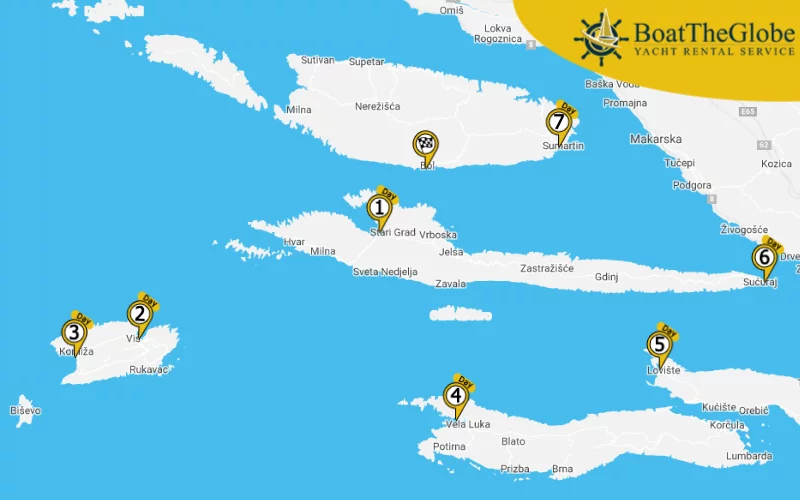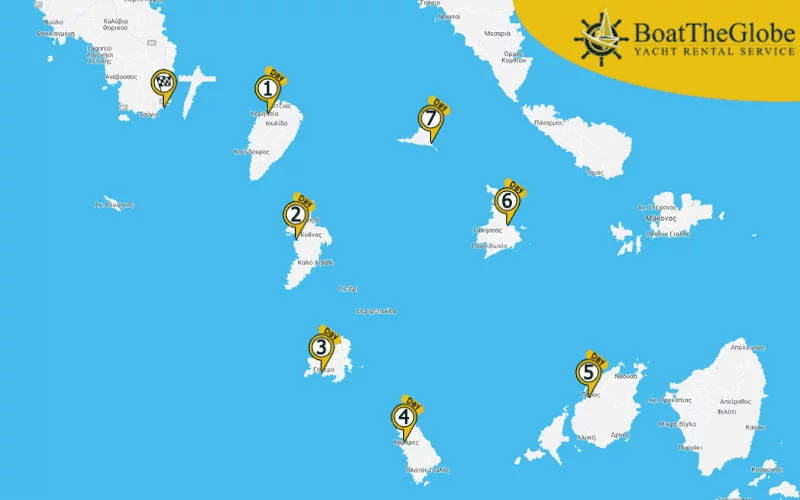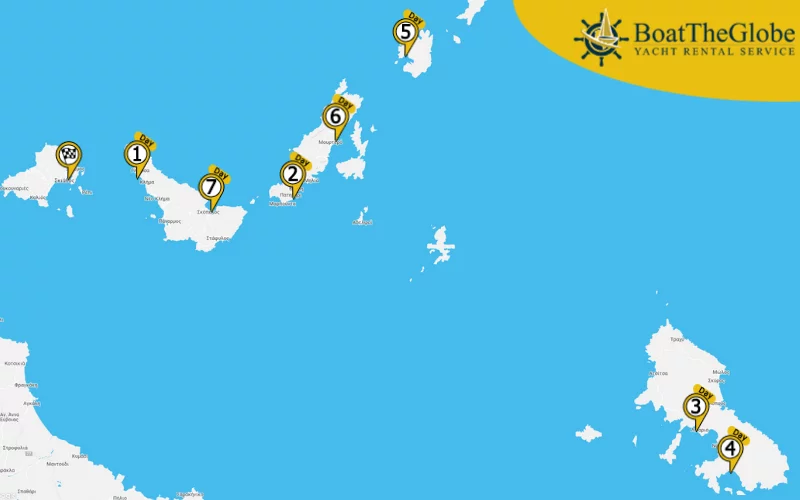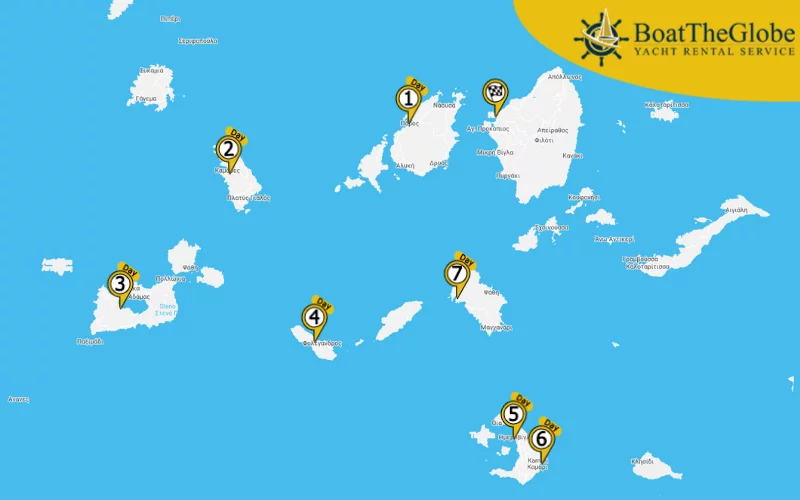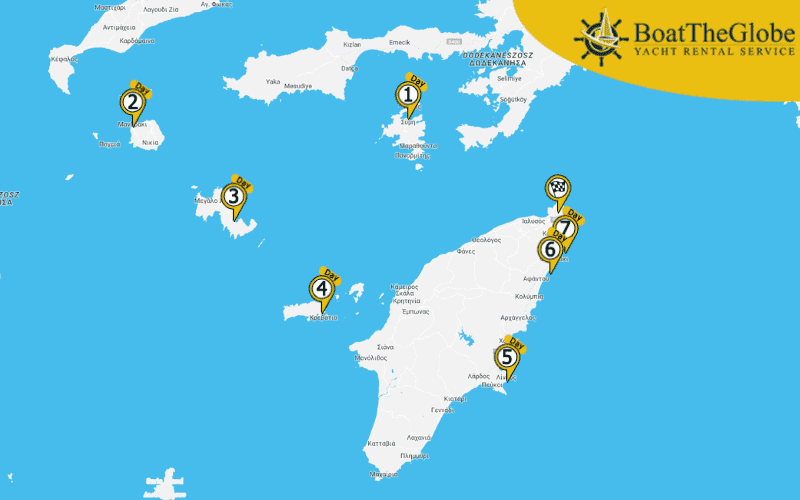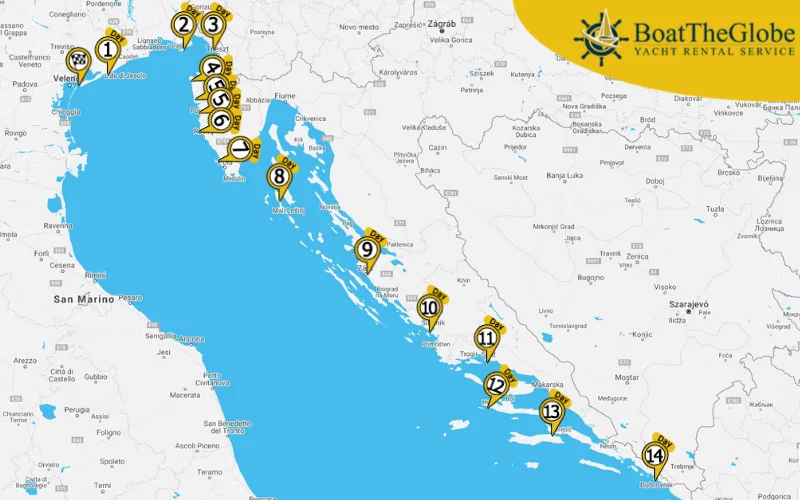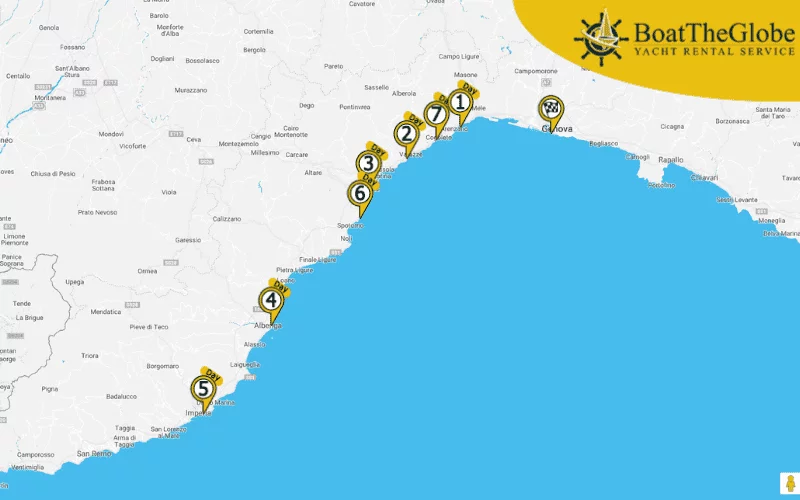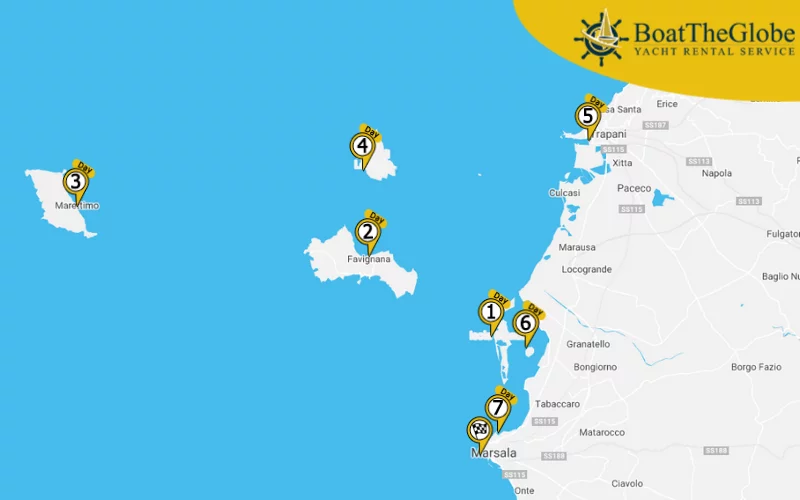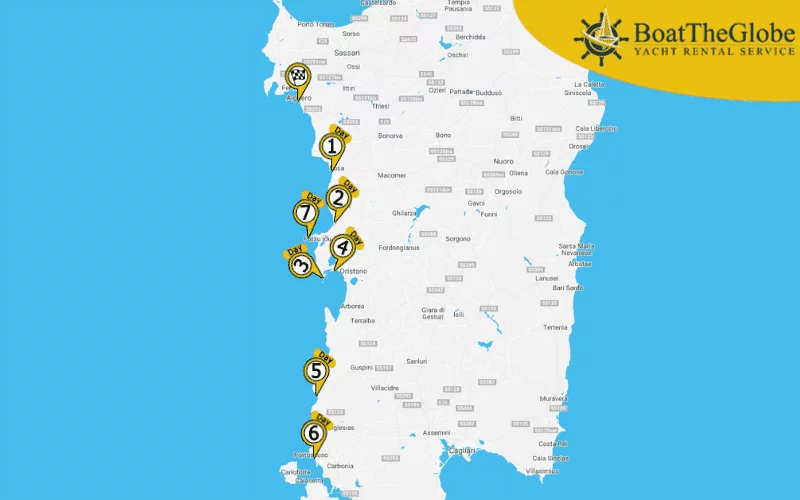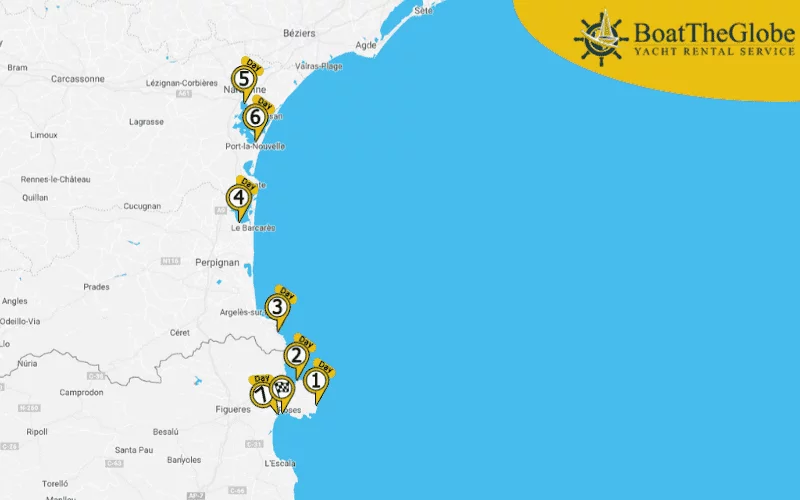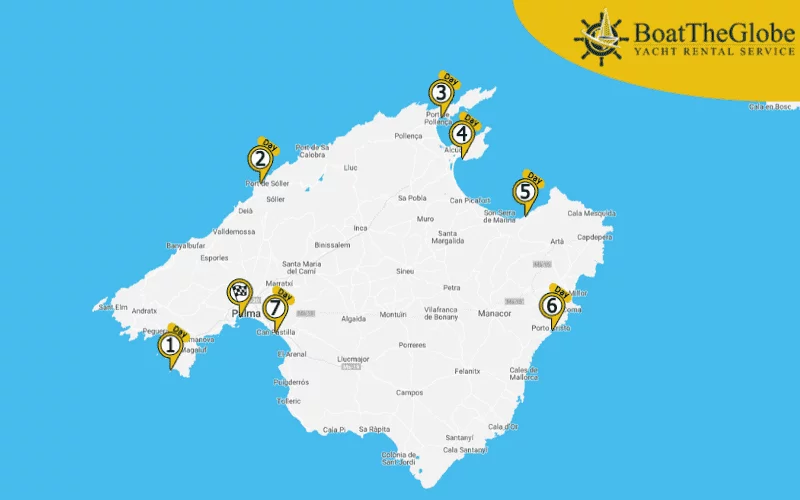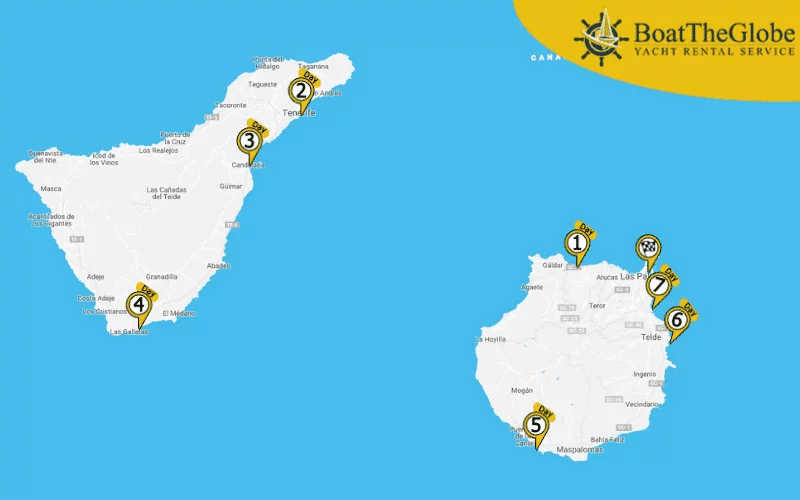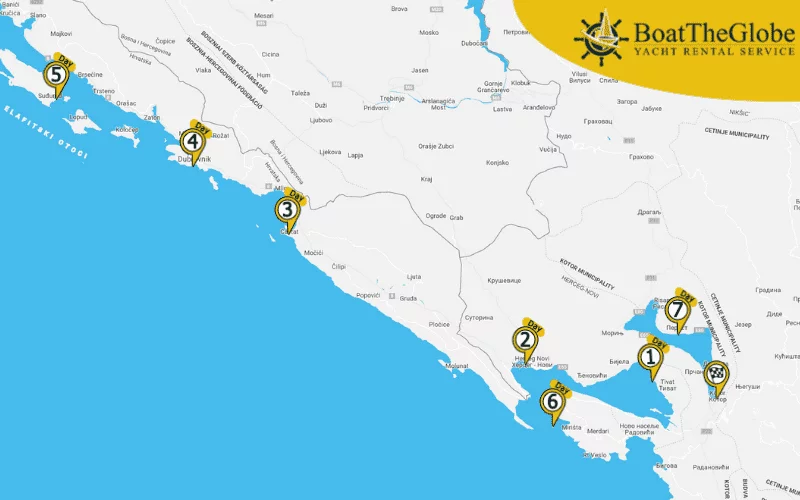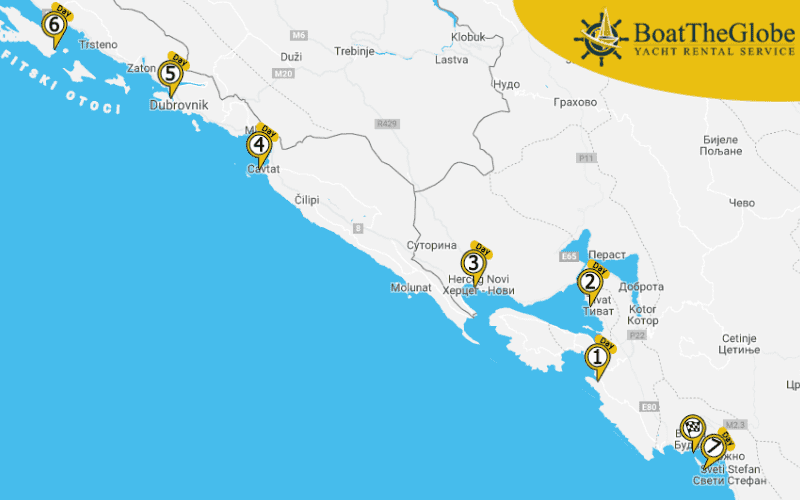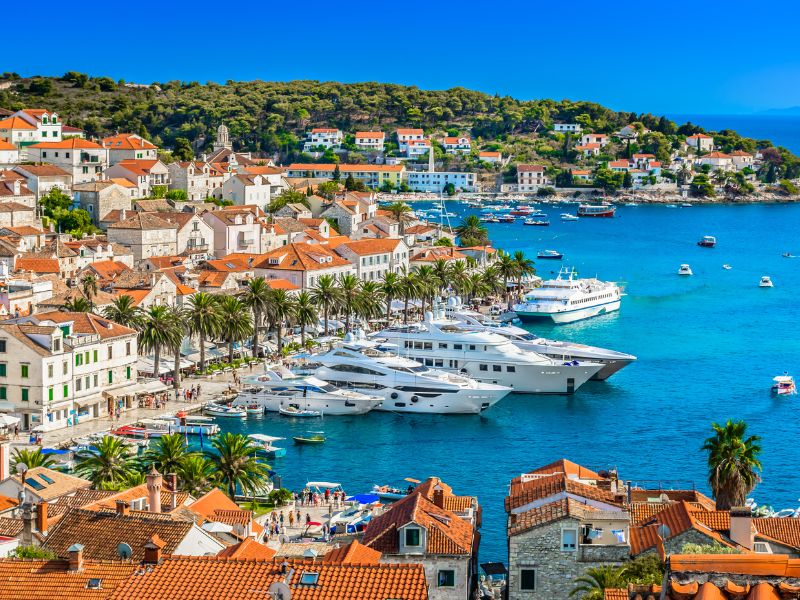Is the Mediterranean Sea good for sailing? Where are the best places for sailing? Are you planning a sailing trip in the Mediterranean? The region of the Mediterranean Sea is characterized by amazing cultural attractions as well as crystal clear water, friendly people and pleasant weather. From this article, you can learn when it is worth visiting the six most popular countries and which region is navigable in a particular season. We will also provide you with 7-day-long sailing itineraries,, ports, yacht rental options & other useful information. If you follow our advice, unforgettable experiences will be in store for you. This article will be the most useful read for those who want a comprehensive but friendly guide to the weather, routes, ports and attractions in Mediterranean.
This article gives you an overview of the following topics:
- What is the best time of the year to sail in the Mediterranean?
- Where is the best sailing in the Mediterranean?
- Mediterranean sailing holidays in Croatia
- Sailing the Mediterranean routes in Greece
- Mediterranean sailing vacations in Italy
- Med sailing holidays in Spain
- France sailing trips in the Mediterranean
- Sailing in Montenegro
What is the best time of the year to sail in the Mediterranean?
What is the Mediterranean yachting season? It is a great experience to take our boat out in the Mediterranean region; the sailing season is very long thanks to the mild weather, which generally runs from April to October. We will give you a brief overview of the season’s different characteristics and the spots that you should visit.
In the autumn
If you do not insist on visiting in the hottest period, the autumn season is perfect for exploring the Mediterranean region as there are no large crowds and the temperatures are also milder. You should still be careful, as the weather often becomes unpredictable in the spring and autumn, combined with strong winds from time to time. During this time, it is safer to stay close to the marinas. Read more about sailing in Turkey, Greece sailing
Can you sail the Mediterranean in winter?
In the winter, it is recommended to monitor the weather forecast due to the variable conditions and frequent storms. The most popular Spanish cities are Valencia, Barcelona and Cartagena in this season. The latter is a perfect starting point when exploring the Balearic Islands, France and Corsica. Licata and Marina di Ragusa are two very popular destinations on the largest island of the Mediterranean Sea: Sicily. Spain sailing.
In the Spring
The region of the Mediterranean Sea is beautiful in the autumn, and it is also very peaceful around here during this time. In this period, we suggest that you head towards Croatia, Greece, Sicily, Sardinia or the Balearic Islands. In Greece, we particularly recommend visiting Lefkada – belonging to the Ionian islands – in the west. The town of Préveza in the southwest and the famous island of Crete are also excellent choices. Read more about Croatia sailing, sailing Sardinia.
In the summer
When summer is approaching, many people sail on the Mediterranean Sea; the busiest months are July and August. Sardinia is among the most popular sailing destinations; the northern and northeastern parts are rich in anchorages, even though they can still get full in the summer. There is a strong summer wind present on the island, so it is recommended to sail counter-clockwise. Would you prefer to avoid large crowds? Spain and France, as well as the southern part of Sardinia, Tunisia, the northern part of the Aegean Sea, and the Peloponnese, are all considered quiet regions. Read more about Italy sailing
Is the Mediterranean Sea good for sailing, the seas rough?
Sailing in the Mediterranean can vary depending on the region and season in terms of sea conditions. In general, the Mediterranean Sea is calm, especially during the peak summer season (June to August) when the seas are calm and the winds are predictable. Some areas, such as the Aegean during the summer Meltem winds, experience rougher seas with strong gusts and choppy conditions. The spring and autumn months can bring more changeable weather, with occasional stormy or windy days with rough seas.
Where is the best sailing in the Mediterranean?
Mediterranean sailing holidays in Croatia
Croatia is a very popular sailing destination due to the crystal clear sea, pleasant summer climate, and unique islands. In addition to the historic towns, many fishing villages and idyllic bays welcome sailors here. There are five national parks on the Croatian coast, three of which are on the seaside: Brijuni, Kornati, and Mljet. If you are sailing in Croatia, you will encounter the delicacies of mostly Mediterranean cuisine, prepared with high-quality ingredients. Local wines are perfect for these dishes. The regions of Istria, Kvarner, and Dalmatia attract millions of tourists annually. Rent a boat in Mediterranean and enjoy complete tranquility as you glide from one beautiful bay to another.
Istrian Peninsula (Istria)
Istria is the largest peninsula in the Adriatic Sea. The highest peak is Mount Učka, offering gorgeous views of the peninsula, Kvarner Bay and its islands. The karst ranges are a paradise for climbers. Many hiking trails lead to the 1401 m high Peak Vojak. The mountain is part of Učka National Park and has rich flora and fauna. Limski Kanal or Lim Channel is a very unique natural formation in Istria. It is a 10 km long sea inlet that stretches deep into the peninsula. The hills that elevate at both sides reach a height of 200 m. You can find Romould’s cave at a height of 120 above sea level. It was named after a hermit who used to live there. You can go to the cave by bike, on foot, or on a guided tour.
Another interesting natural attraction on the west coast of Istria is the Baredine dripstone cave. It is only 7 km from Poreč, next to the village of Nova Vas. In addition to the beautiful stalactite formations, there are two beautiful underground lakes. If you are visiting, sail to the Brijuni archipelago on the southwest coast of Istria. It consists of 14 islands. There is also a safari park, which is home to lush vegetation and many exotic animals. The archipelago got National Park status in 1983. In the summer, the average temperature around the peninsula is 23–28° Celsius, with a sea temperature of 24° Celsius.
Although the sailing season lasts from April to October on the Mediterranean Sea, March and November are also ideal for sailing. The three common winds in the region are the dry Bora, coming from the north; the Jugo, usually followed by rain; and the mild Mistral. More Istria sailing routes, Istria sailing, boat rental Istria
7 days Istria sailing itinerary
Day 1. Pula – Medulin 32.41 km (20.14 nm), Day 2. Medulin – Unije 33.34 km (20.72 nm), Day 3. Unije- Vele Srakane 11.65 km (7.24 nm), Day 4. Vele Srakane – Martinscica 27.22 km (16.91 nm), Day 5. Martinscica – Cres 27.05 km (16.81 nm), Day 6. Cres – Rabac 24, 28 km (15, 09 nm), Day 7. Rabac – Trget – Pula 90.16 km (56.02 nm)
More Pula sailing
Cres (Kvarner Bay)
Cres is the largest island in Croatia. It is located in the northwestern part of Kvarner Bay. One of its most interesting villages is Lubenice which lies on a cliff 382 m above sea level. Lubenice offers a wonderful view of the sea and Sv. Ivan Bay, embraced by a pebble beach. If you are looking for some fun, the village of the same name is home to the Summer Music Festival.
One of the main advantages of the islands of the bay is that there are fewer charter boats here than in Dalmatia. Thanks to this, you can find several moorings even in the high season. Also, the shorter distances between islands and the routes that can be chosen according to the wind provide favourable conditions. If you want to shorten your trip, there are two options: at the Osor drawbridge between the islands of Lošinj and Cres, or between the northern and southern part of Lošinj at the Lošinj drawbridge.
Krk (Kvarner Bay)
It is the second largest island in Croatia, with a coastline of almost 200 km. If you prefer land sports, Krk is perfect for bicycle trips. One of the most beautiful resorts is Baška in a quiet bay where you can even try ziplining. Sliding along the ziplines of different lengths and difficulties is great fun for adults and children alike. This activity is exciting and safe at the same time. The highest point is at 460 m, so you will have a wonderful view of the area. In summer, there are many exhibitions, festivals and concerts on the island. Malinska, in the northwestern part of the island, has a vibrant nightlife.
You can also take a glass-bottom boat and discover the marine life of the sea. Vrbnik is on the east coast of Krk. It is one of the most beautiful places on the island. It lies on top of a 48 m high cliff, so the view is breathtaking. The climatic conditions in the Croatian bay are very favourable, as the bay is protected from strong winds by the mountains of Učka and Velebit. However, the Jugo and the Bora might cause significant waves in the spacious Kvarner Bay. You can still plan your 7-day trip in a way that the wind will always come from a favourable direction. sailboat charter Krk, catamaran charter Krk, boat rental Krk
A week Kvarner Bay sailing itinerary
Day 1. Novalja – Rab 26, 41 km (16, 41 nm), Day 2. Rab – Krk 38, 64 km (24, 01 nm), Day 3. Krk – Rijeka 43, 85 km (27, 25 nm), Day 4. Rijeka – Rabac 36, 36 km (22, 59 nm), Day 5. Rabac – Pula 65, 13 km (40, 47 nm), Day 6. Pula – Mali Losinj 72, 26 km (44, 90 nm), Day 7. Mali Losinj – Ilovik – Novalja 14, 76 km (9, 17 nm) – 29, 07 km (18, 06 nm)
Brač (Dalmatia)
There are about 926 smaller and larger islands, rocks, and reefs in the waters of Dalmatia. Brač is the third largest among the Adriatic islands, and also the highest. In clear weather, you can see Dalmatia from the top of Vidova Gora. Situated in the most protected bay on the island, Milna is popular among sailors. The marked trails of Brač are perfect for hiking. You can find Zmajeva špilja or Dragon Cave next to Bol, near Murvica. Accompanied by a guide, you will discover the remains of the chapel and the residence of hermits who lived here.
The 12 km2 large Sutivan Nature Park is located in the northern part of Brač, 3 km west of Sutivan. Visiting this gorgeous place is recommended for all ages. You should also check out the International Brač Summer Carnival. It is a 7-day festival taking place in a different village every day. If you want to experience the vibrant nightlife, you can choose from great clubs like Havana, Paparazzo, or Thriller.
The beautiful Dalmatian region has a Mediterranean climate. The annual average temperature can go above 15° Celsius in several areas. Summers are hot and mostly dry, and it rarely snows in the winter. You can expect thunderstorms anytime during the year. The prevailing wind direction is northwestward; the other dominant winds are the Sirocco, the Bora and the Mistral. More Dalmatia sailing routes, Dalmatia sailing, or yacht charter Dalmatia .
7 days Dalmatia sailing itinerary
Day 1. Bol – Stari Grad (Mooring Bouys) 15, 59 km (9, 69 nm), Day 2. Stari Grad (Mooring Bouys) – Vis (Marina Vis) 36, 41 km (22, 62 nm), Day 3. Vis (Marina Vis) – Komiža 19, 71 km (12, 25 nm), Day 4. Komiža – Vela Luka 57, 84 km (35, 94 nm), Day 5. Vela Luka – Lovište 42, 09 km (26, 15 nm), Day 6. Lovište – Sućuraj 22, 07 km (13, 72 nm), Day 7. Sućuraj – Sumartin – Bol 51, 17 km (31, 8 nm)
More Croatia sailing destinations or boat hire Croatia, Croatia luxury yacht charter, skippered yacht charter Croatia, bareboat yacht charter Croatia, catamaran charter Croatia, gulet charter Croatia, luxury sailing yacht charter Croatia
Sailing the Mediterranean routes in Greece
Greece is located in Southeast Europe, in the southern part of the Balkan Peninsula. The crystal clear water, the islands sparkling like gems, and the beautiful coastal towns all make Greece an attractive destination among tourists. The distances between the Greek islands are larger compared to that of the Croatian archipelago, so the waves might cause some inconvenience. Skippers mostly know the 6 main regions of Greece. Read about sailing in Greece September, or in October
Ionian Islands
The Ionian Islands are located in the western part of Greece, in the continuation of the Adriatic. The seven larger islands are Corfu, Paxos, Lefkada, Ithaka, Kefalonia, Zakynthos, and Kythira. The most unique attractions on Zakynthos – an island also known as the “Flower of the East” – are the Blue Caves, located in the northwestern part. Besides its beauty, the stranded little bay of Navagio is also famous for an old shipwreck.
The warmest period lasts from June to September on the islands of the Ionian Sea. The Gregale – the local wind coming from the northeast – makes the summer heat more bearable. In Corfu, the average temperature is lower compared to other parts of Greece: during the summer months, it is 28–31° Celsius, with a water temperature of 21–25° Celsius. Going towards the south, of course, the temperature of the air and the water gradually increases. For instance, on the island of Kythira – located near the Peloponnese peninsula – the average temperature in July is 32–35° Celsius. The level of precipitation is the highest in this region among the Greek islands. A typical example of the “green Mediterranean climate” is the popular resort, Corfu. bareboat charter Ionian, catamaran charter Ionian, Ionian yacht charter
The peninsula of Peloponnese and the Corinth Canal
The peninsula of Peloponnese is the southernmost part of the mainland of Greece. It practically became an island with the establishment of the 6-kilometre-long waterway, the Corinth Canal in 1893. The most important town in the region is Corinth itself. The venue of the ancient Olympic Games, Olympia can be found in this region along with the Ancient Theatre of Epidaurus, the mountain of Taygetos, and Sparta. The region offers diverse beaches and bays, as well as unique gastronomic experiences to tourists. July and August are very hot, with the temperature often above 40° Celsius. When sailing around the Peloponnese, we should prepare for the unpredictable winds that influence the southernmost part of the island. yacht charter Peloponnese
Athens and the islands of the Saronic Gulf
The amazing Athens is the capital of Greece. We can start our trip here, as the islands of the Saronic Gulf are especially ideal for sailing. The islands located in the bay area: are Salamis, Aegina, Agistri and Poros. Thanks to the fact the capital is located nearby, this might be the most crowded region. The most interesting attractions on Poros include the Lemon Forest, located opposite the port. You can walk among over 30, 000 lemon and orange trees in this wonderful spot.
There is a semiarid subtropical climate in Athens. The temperature is usually 28–35° Celsius in the summer. During this time, the level of humidity is low and there are frequent air movements; in the summer months, there is a low amount of precipitation. The islands of the Saronic Gulf are perfect destinations for skippers with less experience because of the shorter distances and fairly moderate winds. sailing destinations in Saronic-gulf, boat rental Saronic
A week-long Saronic Gulf sailing plan
Day 1. Lavrion – Coressia (Kea island) 28, 09 km (17, 46 nm), Day 2. Coressia – Merihas (Kithnos island) 37, 98 km (23, 60 nm), Day 3. Merihas – Livadi (Serifos island) 46, 67 km (29, 00 nm), Day 4. Livadi – Kamares (Sifnos island) 23, 57 km (14, 64 nm), Day 5. Kamares – Paros 54, 25 km (33, 71 nm), Day 6. Paros – Ermoupoli (Siros island) 45, 48 km (28, 26 nm), Day 7. Siros – Giaros Lavrion 102, 29 km (63, 56 nm)
The Sporades and the Chalkidiki peninsula in the eastern part of the Aegean Sea
The Sporades is the collective name of the islands scattered around the northern basin of the Aegean Sea, while the Chalkidiki peninsula is located in the northwestern part of the sea. Only 4 members of the Sporades are inhabited: Skiathos, Skopelos, Alonnisos and Skyros. All of these islands are beautiful, and the sea around them is incredibly clear and blue. The Chalkidiki peninsula is also characterised by a crystal clear sea; they also call the peninsula the “secret paradise of Greece” because of the unspoiled natural environment. Its tiny bays are ideal anchorages; the stone pines, olive groves, and picturesque villages have an enchanting effect on tourists. Sporades sailing routes, boat rental Sporades
7 days Sporades sailing trip
Day 1. Skiathos – Loutraki (Skopelos) 10.68 km (6.63 nm), Day 2. Loutraki (Skopelos) – Patitiri (Alonissos) 31.79 km (19.75 nm), Day 3. Patitiri (Alonissos) – Linaria (Skyros) 67.36 km (41.85 nm), Day 4. Linaria (Skyros) – Skyros (Skyros) 41.63 km (25.87 nm), Day 5. Skyros (Skyros) – Kira Panagia 67.67 km (42.05 nm), Day 6. Kira Panagia – Kalamakia (Alonissos) 17.54 km (10.90 nm), Day 7. Kalamakia (Alonissos) – Skopelos (Skopelos) – Skiathos 48.90 km (30.38 nm)
The Chalkidiki peninsula, located in the southern part of Macedonia, has a dual climate. it is the Mediterranean on the beach, while the inner parts of the peninsula have continental weather. In the summer, the temperature can even go above 30° Celsius; the weather is very pleasant until October. The Meltemi is less strong on the Sporades and on Chalkidiki than on the Cyclades or in the Dodecanese in the southern parts of the Aegean Sea. yacht charter Chalkidiki
The Cyclades
The Cyclades archipelago refers to the islands located around Delos, in the central region of the Aegean Sea. The most popular ones are Mykonos, Santorini and Crete. The Cyclades are among the most beautiful islands in the world thanks to the giant mountains, white houses and golden sandy beaches. Summers are very hot, but the ever-blowing Meltemi from the Cyclades somewhat compensate for the heat. We recommend visiting the region for more experienced skippers. On the island of Mykonos, due to the winds, the sea water is fairly cold even during mid-summer. In the warmest season, the precipitation is very low. Cyclades sailing routes, boat rental Cyclades islands
7 days Cyclades sailing trip
Day 1. Naxos (Naxos) – Parikia (Paros) 28, 45 km (17, 68 nm), Day 2. Parikia (Paros) – Sifnos 53, 94 km (33, 52 nm), Day 3. Sifnos – Milos 43, 65 km (27, 12 nm), Day 4. Milos – Folegandros 62, 74 km (38, 99 nm), Day 5. Folegandros – Thira (Santorini) 50, 27 km (31, 24 nm), Day 6. Thira (Santorini) – Kamari (Santorini) 23, 48 km (14, 59 nm), Day 7. Kamari (Santorini) – Ios – Naxos (Naxos) 90, 92 km (56, 49 nm)
The Dodecanese
The Dodecanese
archipelago is located in the southeastern part of the Aegean Sea. It consists of 12 larger apps. 50 smaller islands. The most famous islands of the region are the picturesque Rhodes and the verdant Kos. Kalymnos – the island famous for the sea sponges – attracts more and more tourists year by year. Similarly to other parts of Greece, the sailing season lasts for 9 months, from March to November. The prevailing wind is the Meltemi, blowing from a northwestern direction in the Dodecanese from June. Heading south, the temperature of the air and the sea gradually increases. In the summer, the temperature is 33–35˚ Celsius; the constant winds offer some compensation for the hot weather. The sea temperature is 24–26˚ Celsius. Dodecanese yacht routes, yacht charter Dodecanese
A week-long Dodecanese sailing itinerary
Day 1. Rhodes – Ano Symi 45.66 km (28.37 nm), Day 2. Ano Symi – Mandraki 72.02 km (44.75 nm), Day 3. Mandraki – Livadia (Tilos Island)36.33 km (22.57 nm) , Day 4. Livadia – Chalki (Chalki island) 34.47 km (21.42 nm) Day 5. Chalki – Lindos 83.93 km (52.15 nm), Day 6. Lindos – Antony Quinn Beach 28.24 km (17.55 nm) Day 7. Antony Quinn Beach – Faliraki – Rhodes 17.14 km (10.65 nm).
Mediterranean sailing vacations in Italy
Italy consists of the Appenine Peninsula (“The Boot”), Sicily and Sardinia as well as several other tiny islands. Its 8600-kilometre-long coast offers great sailing destinations and unforgettable experiences. Skippers might be familiar with the 6 main regions of Italy: the Adriatic, the Riviera, Tuscany, the Gulf of Naples, Sardinia and Sicily.
North Adriatic coast
The Italian Adriatic coast runs 600 kilometres long from Venice to Puglia. The most popular towns in the region are: Lido di Jesolo, Lignano, Rimini, Bibione and Caorle, offering dozens of places worth visiting. You can go on a nice wine tour in Bibione, while the picturesque Caorle is known as “Little Venice”. The world of lagoons in the area and the typical fishing cabins are wonderful sights. If you like partying, you should choose from the great clubs of Bibione, Lido di Jesolo and Caorle. The port of Trieste is the most important port on the Italian Adriatic and is also among the largest ports in Italy.
The Italian Adriatic has a Mediterranean climate. In July, the average temperature is 30° Celsius, and the lowest temperature in January is 7° Celsius. The sailing season is between April and October. The region is ideal for less experienced sailors thanks to the mild winds and the fact that it is easily navigable.
14 days North Adriatic sailing plan
Day 1. Venice (Marina di Lio Grando) – Cortellazzo 30, 10 km (18, 71 nm), Day 2. Cortellazzo – Grado 54, 50 km (33, 87 nm), Day 3. Grado – Triest 31, 22 km (19, 40 nm), Day 4. Triest – Umag 35, 63 km (22, 14 nm), Day 5. Umag – Novigrad – Porec 26, 04 km (16, 18 nm), Day 6. Porec – Rovinj 17, 73 km (11, 02 nm), Day 7. Rovinj – Pula 30, 69 km (19, 07 nm), Day 8. Pula – Losinj (Nerezine) 64, 41 km (40, 02 nm), Day 9. Losinj – Zára 88, 50 km (54, 99 nm), Day 10. Zadar – Sibenik 75, 75 km (47, 07 nm), Day 11. Sibenik – Split 64, 38 km (40, 01 nm), Day 12. Split – Hvar 42, 83 km (26, 61 nm), Day 13. Hvar – Korcula 62, 45 km (38, 81 nm), Day 14. Korcula – Dubrovnik (ACI Marina Dubrovnik) 88, 54 km (55, 02 nm).
Italian Riviera
We recommend visiting the Italian Riviera – the Ligurian coast – for those who want to get to know the traditional side of the country. The capital of the region is Genoa, and its most popular spot is Cinque Terre. The Riviera offers an azure blue sea and charming villages to its visitors; Liguria is rich in natural reserves as well. The flowers, palm trees, pines, olive and lemon groves and vineyards make a breathtaking sight.
The region consists of two parts: The western side is known as Riviera di Ponente, which has wide shore segments and offers beautiful sunsets. Riviera di Levante, which is the eastern part, is surrounded by cliffs and is characterised by untouched territories. The tiny Portofino is a true gem of the Ligurian coast and is considered one of the most beautiful towns in Italy. Genoa has been the largest and most significant port of the country for centuries.
The region has a very pleasant climate thanks to the protection provided by the Alps: hot summers and mild winters, with a large amount of sunshine during the entire year.
A week-long Italian Riviera sailing trip
Day 1. Genova – Arenzano 21.39 km (13.29 nm), Day 2. Arenzano – Varazze 11.54 km (7.17 nm), Day 3. Varazze – Savona 9.61 km (5.97 nm), Day 4. Savona – Albenga 34.69 km (21.55 nm), Day 5. Albenga – Imperia 25.67 km (15.95 nm), Day 6. Imperia – Vado Ligure 60.45 km (37.56 nm), Day 7. Vado Ligure – Cogoleto – Genoa 46.87 km (29.12 nm)
Tuscany
Tuscany, another region famous for its unique beauty, is famous for the wine regions and the gastronomy. Its towns offer zoos, adventure parks and waterparks, so it is a perfect destination for families with children. Besides the 7 largest islands – Elba, Giglio, Capraia, Giannutri, Pianosa, Montecristo and Gorgona – the Tuscan Archipelago has almost 40 tiny further islands as well. Elba, an island rich in wonderful orchids, is located only 10 kilometres from the Italian peninsula. It is a paradise for sports enthusiasts with its tennis and golf clubs, as well as sailing, surf and diving schools. We can also do wall-climbing and try the exciting activity of parachuting.
Tuscany has a very diverse climate, influenced by the sea from the west and the Apennines from the north and the east. The beach and the coastal area, however, are definitely Mediterranean with dry summers and rarely freezing winters. The annual average temperature is 15-16° Celsius. The amount of sunshine is the highest around Grosseto. As for the winds, the Sirocco may cause some inconvenience as it can blow the African sand all the way to the shores of Tuscany.
The Gulf of Naples
The Gulf of Naples, which is app. 15 kilometres wide, belongs to the Tyrrhenian Sea, located along the southwestern coast of Italy. It is bordered by the Gulf of Pozzuoli and Naples from the north, the Vesuvius from the east, and the Sorrento Peninsula from the south. Its islands are Capri, famous for the Blue Cave; Ischia, often called the Green Island; and the picturesque Procida. Sorrento, located on the southeastern coast of the Gulf of Naples, is considered a “gate” of the beautiful Amalfi Coast.
The wonderful bay has a Mediterranean climate. The average maximum temperature is 30° Celsius in August, and the lowest temperature is 12° Celsius in January. The temperature of the sea is between 15° Celsius and 28° Celsius. We recommend visiting the region between May and October when we can expect pleasant temperatures and rare precipitation.
Sicily
Sicily is the largest island on the Mediterranean Sea and is the largest region in Italy as well. Its port city, Palermo is rich in interesting architecture; the Orto Botanico botanical garden, built in 1779 is a great attraction. You can admire tropical and subtropical trees, cacti, parrots, small ponds and statues in this nice, shady place. The most interesting sight in Sicily is the highest active volcano in Europe, the 3329-metre-high Etna.
Are you planning an active holiday here? Then come in May, June, September or October. The temperature at this time reaches 24-26 degrees in the daytime. As far as longer relaxing beach time is concerned, July and August are the perfect months. The daytime temperature is about 30 whereas the sea temperature can go up to 26 degrees. Want to avoid the very hot season? Sicily is still waiting for you from May to October. Of course, the sea temperature is still pleasant at this time. The cooler period is between October and April; the winter is short and mild. In the main sailing season, the sea wind arrives from the northwest.
A week-long Sicily sailing trip
Day 1. Marsala – Isola Grande 11.47 km (7.12 nm), Day 2. Isola Grande – Favignana 16.33 km (10.15 nm), Day 3. Favignana –Marettimo 23.49 km (14.59 nm) , Day 4. Marettimo – Isola Levanzo 23.38 km (14.53 nm), Day 5. Isola Levanzo – Trapani 14.87 km (9.24 nm), Day 6. Trapani – Mozia 17.54 km (10.90 nm), Day 7. Mozia – Parco – Salinella 14.10 km (8.76 nm)
Sardinia
As the Mediterranean’s second-largest island it awaits tourists with countless attractions Cagliari is not just the capital city of Sardinia, but one of the most impressive ports towns of the Mediterranean. Regular ferries leave towards Civitavecchia, Palemo and Naples. The Orto Botanico dell’Università di Cagliari botanical garden has a collection of Mediterranean plants, succulents that survive without water for a long time, and tropical plants as well.
The island has typical Mediterranean weather. Summers are long and hot, and winters are wet. In July and August, the average temperature is 24-25°C. November and December are the rainiest. On the parts near the sea, the weather hardly drops below 0°C. In January and February, the temperature is around 10°C. The dominant winds here are the Mistral and the Sirocco. The former is mainly present in the northern and western parts. Several wind turbines have been built, benefiting from the windy climate. If you do not insist on visiting on the hot days, you should visit the island in the spring and autumn as well. The weather is suitable both for travelling and hiking. Would you also like to swim? Then we recommend the period between the end of May and the beginning of September.
A week-long Sardinia sailing itinerary
Day 1. Alghero – Bosa 35.63 km (22.14 nm), Day 2. Bosa – Santa Caterina di Pittinuri 21, 65 km (13, 45 nm), Day 3. Santa Caterina di Pittinuri – San Giovanni di Sinis 31, 35 km (19, 48 nm), Day 4. San Giovanni di Sinis – Oristano (Marina di Torre Grande) 11, 57 km (7, 19 nm), Day 5. Oristano (Marina di Torre Grande) – Buggerru 58, 42 km (36, 30 nm), Day 6. Buggerru – Portoscuso 26, 67 km (16, 57 nm), Day 7. Portoscuso – Mandriola – Alghero 154, 02 km (95, 71 nm)
Med sailing holidays Spain
Thanks to its favourable location, pleasant climate and natural beauty, Spain is an incredibly attractive tourist destination. It is located on the Iberian Peninsula along with Portugal and Gibraltar. It is bordered by the Bay of Biscay from the north, the Atlantic Ocean from the west and by the Mediterranean Sea from the south and the east. The Balearic and Canary Islands also belong to Spain. The country has beautiful national parks and botanical gardens. Of all European countries, Spain has the most IBAs – Important Bird Areas.
Costa Brava
The famous Costa Brava or “Wild Coast” is located in the northeastern part of Spain, in Catalonia. It runs from the cosy town of Blanes to the French border. It is also a popular destination because it is located near Barcelona. Lloret de Mar is among the most frequently visited holiday resorts in the region, particularly recommended for those who love the buzzing nightlife because of the large amount of clubs. Blanes, located in the southern part of Costa Brava, is famous for the Marimurtra Botanical Garden, exhibiting almost 6, 000 species of flowers and other plants.
The climate of Costa Brava is Mediterranean with warm, dry summers and moderately cold winters. The average annual temperature is between 7 and 28°C. The hottest months are July and August. The latter is especially good for swimming because the average temperature of the sea is 26°C. October gets the most rainfall. This means an average of 82 millimetres. During the summer season, most holiday resorts are extremely crowded. So if you can, you should visit in late August or early September. The weather is still nice, but there are fewer people.
7 days Costa Brava sailing trip
Day 1. Roses – Cadaqués 17.37 km (10.79 nm), Day 2. Cadaqués – El Port de la Selva 20.76 km (12.90 nm), Day 3. El Port de la Selva – Portbou 11.39 km (7.08 nm), Day 4. Portbou – Salses-le-Château (Port Leucate) 54.58 km (33.91 nm) Day 5. Port Leucate – Narbone 36.40 km (22.62 nm), Day 6. Narbone – Lagoon La Berre (Port la Nouvelle) 15, 83km (9, 83 nm), Day 7. Port la Nouvelle – Roses 102.51 km (63.69 nm)
Balearic Islands
The archipelago is located east of the Iberian Peninsula, in the western basin of the Mediterranean Sea. Thanks to its pleasant climate and suitable conditions, it is regarded as one of the most popular holiday resorts in Europe. The 5 largest members of the archipelago are Mallorca, Menorca, Ibiza, Formentera, and Cabrera. Mallorca is the largest island in Spain; the Serra de Tramuntana mountain range is a UNESCO World Heritage Site. Menorca is the second-largest member of the Balearic Islands where you can admire several species of animals and plants that can only be seen here. A significant part of the island is a UNESCO World Heritage Site. Ibiza is a paradise for those who love the nightlife, so it’s mainly popular among youngsters. The world’s largest club, the Privilege is located here; it has a capacity of 10, 000 people.
Even though the days are mostly sunny, it often rains in the summer. During the winter period, there is a larger amount of precipitation, and there are colds winds coming from the sea. The sailing season in the middle of the Adriatic Sea starts in April and ends in October. Between the autumn and spring periods, stronger winds arrive at the Balearic Islands, such as the Mistral in the northwest, the Vendaval from Gibraltar, the Levante from the east and the African Sirocco. Summers are characterised by southeastern winds.
A week-long Balearic Islands sailing itinerary
Day 1. Palma de Mallorca – El Toro 23.23 km (14.43 nm), Day 2. El Toro – Port de Sóller 8.24 km (36.19 nm), Day 3. Port de Sóller – Port de Pollença 65.76 km (40.86 nm), Day 4. Port de Pollença – Alcúdia 22.87 km (14.21 nm), Day 5. Alcúdia – Colonia de Sant Pere 19.48 km (12.10 nm), Day 6. Colonia de Sant Pere – Porto Cristo 48.06 km (29.87 nm), Day 7. Porto Cristo – Ca’n Pastilla – Palma 94.05 km (58.44 nm)
Canary Islands
The wonderful Canary Islands consist of seven larger and several smaller islands. Tenerife is the largest and most popular one of them. The highest point of Spain can also be found here: the 3718-metre-high Teide offers plenty of hiking opportunities. Grand Canaria has the most diverse landscape among the islands. If you prefer active recreation, there are several cycling routes and hiking trails to choose from.
There is a subtropical climate in the Canary Islands, with pleasant warmth and a small amount of precipitation. There are 11 different types of winds; the Passat is the prevailing wind in the summer, and the winter is characterised by the western winds that bring precipitation. The Sirocco is a desert wind, while the Calima comes from the Sahara and brings a large amount of dust. The latter is mainly present in the spring and the summer. Thanks to the cold Canary Current, the temperature of the sea is particularly cold compared to its geographic location: only 18–22° C.
7 days Canary Islands sailing trip
Day 1. Las Palmas de Gran Canaria – El Pagador 28.04 km (17.42 nm), Day 2. El Pagador – Santa Cruz de Tenerife 74.85 km (46.51 nm) , Day 3. Santa Cruz de Tenerife – Candelaria 19.11 km (11.88 nm), Day 4. Candelaria – Amarilla Golf 51.65 km (32.09 nm), Day 5. Amarilla Golf – Arguineguín 96.47 km (59.94 nm), Day 6. Arguineguín – Taliarte 52.94 km (32.90 nm), Day 7. Taliarte – Mercalaspalmas – Las Palmas de Gran Canaria 18.94 km (11.77 nm)
France sailing trips in the Mediterranean
France is the largest Western European country and is a paradise for channel sailing. Channel sailing means sailing in channels established in European inland waters – rivers and lakes – for cruising. Its greatest advantage is that you don’t have to deal with the wind, the waves, the currents or the tides. The only challenge is passing through the floodgates and the bridges. It is not even required to have a boating license for channel sailing, as this form of cruising is only possible in waterways where there is no commercial traffic. The cabins are comfortable and heated, so you can use them from early Spring to late Autumn, or even during the winter in certain regions.
French Riviera
The French Riviera or Côte d’Azur (Azure Coast) is the Mediterranean coastline’s 120-kilometre-long section between Marseille and Menton. The incredibly blue sea and the famous holiday resorts such as Cannes and Nice attract a lot of tourists every year. The Cannes Film Festival – organised annually – makes the French Riviera a centre for celebrities. Nice, located in a breathtaking environment, offers delicious gastronomy for those who like Mediterranean dishes. The Mercantour National Park, built in 1979, provides visitors with great hiking opportunities and has incredibly diverse flora and fauna.
The region has a Mediterranean climate; the temperatures are pleasant during most of the year, and there is a large number of sunshine hours. Nice is protected from the strong winds by the mountains.
Corsica
Corsica is the fourth-largest island on the Mediterranean Sea; only Sicily, Sardinia, and Cyprus are larger. Locals call it “Île de Beauté” – the Island of Beauty. The well-established modern tourist paradises, the untouched rocky beaches and the long mountain ranges all have an enchanting effect on tourists. If you are planning an active holiday, you can choose from great climbing opportunities and hiking trails. There are only a few marinas on the eastern side, while the northern and western parts offer several yacht marinas. Corsica is also famous for its unique gastronomy, which is a mixture of French and Italian cuisine.
The islands, which are also the birthplace of Napoleon Bonaparte, have a Mediterranean climate. Summers are hot and dry, while winters are mild but wet. We might experience a sudden change of weather conditions among the high mountains. There are a lot of winds present in the area, namely the Mistral, the Libecciu, the Tramontana, the Ponente, the Gregale and the Levante. The prevailing wind is the Mistral, blowing from the north.
Sailing in Montenegro
Picturesque Montenegro is located in Southern Europe, on the Balkan Peninsula. Its name means “Black Mountain” – there are 2000-metre-high mountains and turquoise water surrounded by beautiful bays here. Montenegro can be divided into 3 parts: the coastal region, the Bay of Kotor and the central regions. The latter belongs to the Dinaric Alps.
Bay of Kotor
The Bay of Kotor, located on the southeastern coast of the Adriatic, is a true gem of Montenegro. The beautiful natural formation reaches almost 30 kilometres long into the mountains. The most important towns are Herceg Novi, which is the main entrance to the Bay of Kotor; Tivat and the famous Kotor. The latter is a UNESCO World Heritage Site, and is among the best-preserved Mediterranean medieval cities today. The narrowest point of the bay is the 340-metre-wide Verige Strait.
The Bay of Kotor is characterised by pleasant, moderate weather with warm, dry summers and mild winters. The average annual temperature is 14.9°C. The hottest months are July and August, the coldest is January. The nearby mountains make it easier to endure even the hottest days. The average temperature in July is 23.7°C and 6.6°C in January. Maximum rainfall occurs in November. Thanks to the pleasant climate, it is recommended to visit Kotor from April to October.
7 days Bay of Kotor sailing trip
Day 1. Kotor – Tivat (Porto Montenegro) 15, 29 km (9, 50 nm), Day 2. Tivat (Porto Montenegro) – Herceg Novi (Harbor) 13, 76 km (8, 55 nm), Day 3. Herceg Novi (Harbor) – Cavtat (Harbor) 44, 80 km (27, 84 nm), Day 4. Cavtat (Harbor) – Dubrovnik (ACI Marina) 23, 13 km (14, 38 nm), Day 5. Dubrovnik (ACI Marina) – Sudurad 18, 48 km (11, 48 nm), Day 6. Sudurad – Mamula-island – Molunat 65, 81 km (40, 89 nm), Day 7. Molunat – Perast – Kotor 29, 49 km (18, 33 nm).
More Montenegro sailing tours.
Coastal region
The shore segment – almost 300 kilometres in length – runs from Croatia to Albania. Its most beautiful and also most famous town is Budva, often referred to as a “miniature Dubrovnik”. Its old city can be found on a small peninsula; they often organise theatre performances and other events here. The smallest island of Montenegro, the world-famous Sveti Stefan is located in the coastal region.
Budva has typical Mediterranean weather with hot and dry summers and mild, wet winters. The warmest month is July when the average temperature may even reach 27°C. Most of the precipitation comes in November and December, and July is the driest month. We recommend that you visit Budva anytime between May and October due to the pleasant weather. Do you love swimming? The average temperature of the sea might reach 25°C
A week-long Coastal region sailing itinerary
Day 1. Budva – Bigova 20.59 (12.80 nm), Day 2. Bigova – Tivat (Porto Montenegro) 29.40 km (18.27 nm), Day 3. Tivat (Porto Montenegro) – Herceg Novi (Harbor) 13.76 km (8.55 nm), Day 4. Herceg Novi (Harbor) – Cavtat (Harbour) 44.80 km (27.84 nm), Day 5. Cavtat (Harbour) – Dubrovnik (Orsan) 19.93 km (13.39 nm), Day 6. Dubrovnik (Orsan) – Sudurad 15.26 km (9.48 nm), Day 7. Sudurad – St Nicholas Island – Budva 95.03 km (59.05 nm).
The region of the Mediterranean Sea offers great sailing destinations where you will have a wonderful experience. You can choose from the more famous ports as well as the idyllic uninhabited islands, and get to know the amazing gastronomy as well, unique in each region. Rent a boat with us! The most wanted Mediterranean boat rentals:
private yacht charter Mediterranean, crewed yacht charter Mediterranean, catamaran rental Mediterranean, rent a gulet in the Mediterranean, sailboat charter Mediterranean, last minute yacht charter Mediterranean, motor yacht hire Mediterranean, luxury catamaran charter Mediterranean, bareboat catamaran charter Mediterranean, crewed motor yacht charter Mediterranean, bareboat motor yacht charter Mediterranean, Mediterranean sailing yacht charter bareboat, sailing holidays Mediterranean skippered, luxury motor yacht charter Mediterranean, luxury sailing yacht charter Mediterranean, crewed catamaran charter Mediterranean
